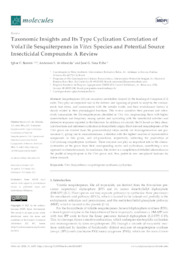Taxonomic insights and Its type cyclization correlation of VolaTile sesquiterpenes in vitex species and potential source insecticidal compounds: a review.
Taxonomic insights and Its type cyclization correlation of VolaTile sesquiterpenes in vitex species and potential source insecticidal compounds: a review.
Author(s): BARRETO, I. C.; ALMEIDA. A. S. de; SENA FILHO, J. G. de
Summary: Sesquiterpenes (SS) are secondary metabolites formed by the bonding of 3 isoprene (C5) units. They play an important role in the defense and signaling of plants to adapt to the environment, face stress, and communicate with the outside world, and their evolutionary history is closely related to their physiological functions. This review considers their presence and extensively summarizes the 156 sesquiterpenes identified in Vitex taxa, emphasizing those with higher concentrations and frequency among species and correlating with the insecticidal activities and defensive responses reported in the literature. In addition, we classify the SS based on their chemical structures and addresses cyclization in biosynthetic origin. Most relevant sesquiterpenes of the Vitex genus are derived from the germacredienyl cation mainly via bicyclogermacrene and germacrene C, giving rise to aromadrendanes, a skeleton with the highest number of representative compounds in this genus, and 6,9-guaiadiene, respectively, indicating the production of 1.10-cyclizing sesquiterpene synthases. These enzymes can play an important role in the chemosystematics of the genus from their corresponding routes and cyclizations, constituting a new approach to chemotaxonomy. In conclusion, this review is a compilation of detailed information on the profile of sesquiterpene in the Vitex genus and, thus, points to new unexplored horizons for future research.
Publication year: 2021
Types of publication: Journal article
Keywords: Biossíntese, Biosynthesis, Inseticida, Taxonomic revisions, Vitex
Observation
Some of Embrapa's publications are published as ePub files. To read them, use or download one of the following free software options to your computer or mobile device. Android: Google Play Books; IOS: iBooks; Windows and Linux: Calibre.
Access other publications
Access the Agricultural Research Database (BDPA) to consult Embrapa's full library collection and records.
Visit Embrapa Bookstore to purchase books and other publications sold by Embrapa.

